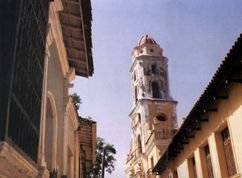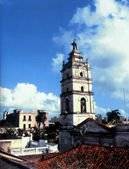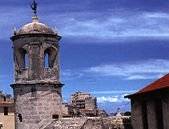Welcome
About us
Travel
tips
SPECIALTIES
Your
itinerary
Your
group
Escorted
tours
Cigar
tour
Golf
Scuba
diving
Fishing
Bird
watching
Ballet
BUSINESS
TRAVEL
Fact-finding
trip
Business
Trip
Incentive
Trade
Show
Conventions
Facilities
Media
& Press
Presentation
PRODUCTS
Packages
Lodging
Int'l flights
Transportation
Private
guide
Insurance
FEEDBACK
WIN
a Trip!
Make money
Your
Comments
ABOUT CUBA
Travel guide
Information
kit
Cultural
events
Sporting
events
In
the press
Music - Live
TRAVEL INDUSTRY
Travel
Agent
Tour
Operator
Providers
NOTICE
Terms
and Conditions
Legal
Site info
FOR
BOOKING
AND
INFORMATION
Contact us!
|
 Seven
treasures of colonial architecture Seven
treasures of colonial architecture
Overview of Cuba - Travel Guide
After Spain decided to
conquer and colonize the island of Cuba, adelantado (royal governor) Don
Diego Velázquez was sent to the New World. Between 1512 and
1519, he founded the first seven Cuban townships, namely Nuestra Señora
de la Asuncion de Baracoa, San Salvador de Bayamo,
Santiago
de Cuba, Sanctisima Trinidad, Sancti Spiritus,
Santa
Maria del Puerto del Principe (now Camaguey), and San Cristóbal
de La Habana. Today, they still preserve a great deal of their
charming and dignified past. Havana and Trinidad are,
without a doubt, the ones that have best maintained their historic cores,
featuring the highest percentage of surviving antique buildings and public
squares and bringing together architectural, historic, and cultural elements
of great value. Both have been designated by UNESCO as World Heritage
Jewels.
 Nevertheless,
the rest are not less noble in lineage and offer a vast array of architectural
and historic monuments, public squares, fortresses, and palaces.
For instance, even though the inhabitants of Bayamo burned their
city to the ground in the early days (1868) of the War of Independence
so it would not fall in enemy hands. Bayamo has nevertheless retained
part of the original parochial church and countless extremely important
historic sites, plus the local color of its traditions, typified by buggy
rides along its venerable streets. Contemporary Camaguey, once
called Puerto Principe, with an old city as large as Havana's
and many times larger than
Trinidad's, will dazzle visitors with
its peculiar small streets, its churches, squares, and mansions, as well
as with its cosy courtyards watched over by the large jar-shaped clay tinajones
used locally as rainwater collectors. Nevertheless,
the rest are not less noble in lineage and offer a vast array of architectural
and historic monuments, public squares, fortresses, and palaces.
For instance, even though the inhabitants of Bayamo burned their
city to the ground in the early days (1868) of the War of Independence
so it would not fall in enemy hands. Bayamo has nevertheless retained
part of the original parochial church and countless extremely important
historic sites, plus the local color of its traditions, typified by buggy
rides along its venerable streets. Contemporary Camaguey, once
called Puerto Principe, with an old city as large as Havana's
and many times larger than
Trinidad's, will dazzle visitors with
its peculiar small streets, its churches, squares, and mansions, as well
as with its cosy courtyards watched over by the large jar-shaped clay tinajones
used locally as rainwater collectors.
Baracoa and Santiago de Cuba
are charmingly authentic. Located by the sea and  surrounded
by mountains, these cities are famous for their distinctly Carribean flavor.
Santiago's San Pedro de la Roca del Morro castle and Adelantado
Velázquez's house are definitely worth a visit. Baracoa,
Cuba's oldest city and first capital, jealously guards the first Christian
relic of the New World, the Holy Cross of Parra, kept at
Nuestra
Señora de la Asunción Catholic Church. surrounded
by mountains, these cities are famous for their distinctly Carribean flavor.
Santiago's San Pedro de la Roca del Morro castle and Adelantado
Velázquez's house are definitely worth a visit. Baracoa,
Cuba's oldest city and first capital, jealously guards the first Christian
relic of the New World, the Holy Cross of Parra, kept at
Nuestra
Señora de la Asunción Catholic Church.
Updated August
20, 2000
Copyright ©2000 USA CUBA TRAVEL
|


 Seven
treasures of colonial architecture
Seven
treasures of colonial architecture